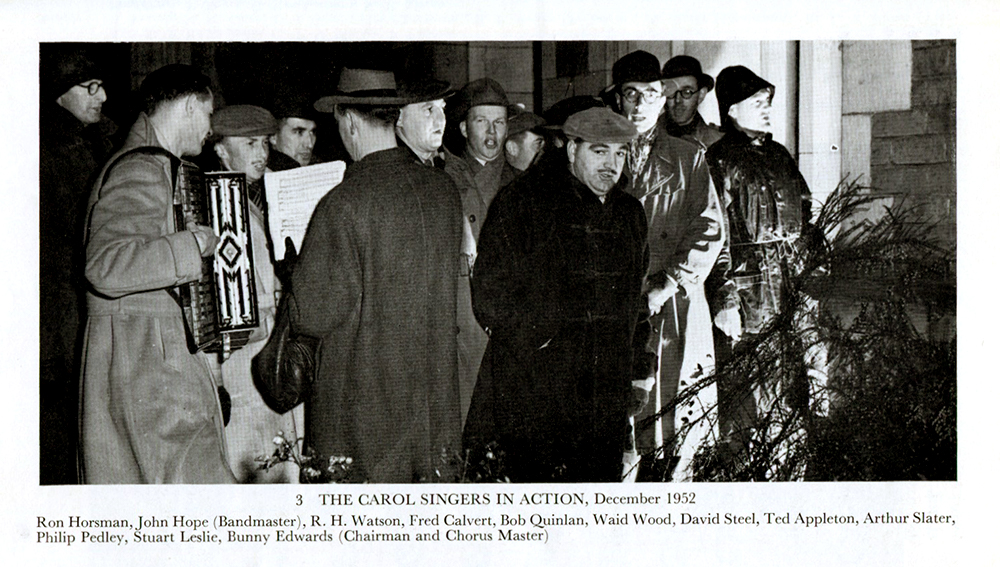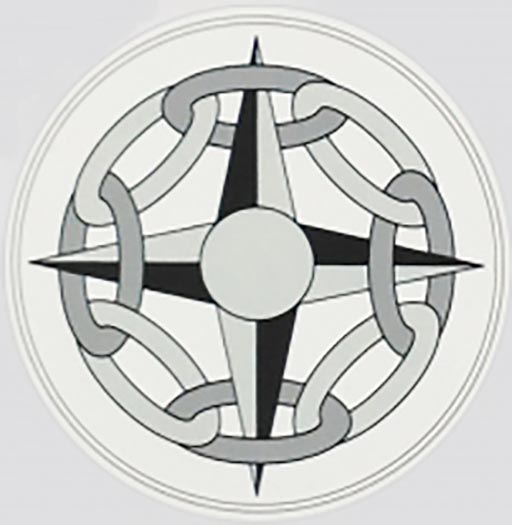The Difficult Years, 1946 – 52
THE TABLE MEETING called pursuant to the minute of 16th October 1942 was held on Friday, 4th October 1946, when lunch was taken by 16 members at the St. Nicholas Hotel,
Twelve years earlier the Table had successfully accomplished its first major task, its own formation, a task in which it had had no previous experience. The present task, in which again it had had no previous experience, was to revive itself from its long and enforced coma.
The same old members got together, all from four to seven years older and perhaps wiser. Some, too, in those lost years had passed the 40-mark. They were the same, yet not the same. Others, for one reason or another, did not reappear at all.
It was obvious that after a gap in recruitment of seven years the average age of the Table had taken a leap upwards. For some time to come there would inevitably be an old brigade of experienced members and an inexperienced younger intake of new members.
These matters were discussed by the Council. As a temporary measure Walter Nockels had resumed his interrupted Chairmanship, and the other officers (with the exception of President and Vice-President) were elected to serve until the first post-war Annual General Meeting, the Table’s seventh, which was eventually held on 15th April 1947.
The Council itself resolved to take over the duties of the Membership Committee, which it continued to perform for the next five years. Its first act was to write to all old members asking whether they wished to continue their membership. In the meantime the National Council had been busy and eventually was able to give the Tables a much-needed ruling [21] on the status of the over-40’s:
Any person who was an active member on 30.9.39 and is still in membership is entitled to remain a member until 31.3.48. In all other cases a member must retire at the end of the year in which he attains the age of 40. The Classification of a member over 40 is considered vacant.
The first few post-war meetings had an average attendance of 16, which soon began to climb. At a special evening meeting held five months later, at which Round Table in general and the Scarborough Table in particular were dealt with in some detail, the attendance had risen to 26.
The annual subscription was raised from 15/- to £1.1. The day of the fortnightly lunch was altered to alternate Tuesdays at the Salisbury Hotel at a cost of 5/- plus 6d. gratuity. At this time the Charity Box contained £4.2.4, which was made up to £5 and given to the Mayor’s Flood Relief Fund. The Christmas Lunch and the Annual Dinner and Dance were revived in 1947.
The latter was held on the 27th November at the Pavilion Hotel and the Table, in those days of rationing and shortages, let itself go. The following was the Dinner menu:
Hors d’oeuvre des Epicuriens
Consommé à la Souveraine
Faisan à la Broche
Coeurs de Celeris à la Moelle
Pommes Croquettes et Nature
Salade Verte a l’huile
Ananas Parisienne
Biscuit Glace Formosa
Langues de Chats
Cafe Moka
The dancing then started at 9.15 p.m. An hour and three quarters later Supper was served, with the following menu:
Sandwich Fingers, Chicken, Smoked Salmon, Ox Tongue.
Bridge Rolls, Cheese and Celery, Paté de Foie Gras.
Patties, Turkey, Oyster, Lobster.
Miniature Aspics, Prawn, Anchovy, Lucille.
Gateaux, Suchard, Moka, Parisienne.
Pastries, Eclairs, Linzer, Mille Feuilles, Religieuse.
Sweets, Fruit Cocktail Jellies, Bavarois Rubanne.
Ices, Vanilla, Creme de Menthe.
Petits Fours, Friandises, Fours Sec.
There is a moral here, somewhere, not perhaps obvious to the younger members of the Table. There was a young guest [22] who, some years later, was to become a member of the Table. His comments, which are to be found on a later page, are probably not far from the mark, for he had grown up through the lean years.
‘The cost?’ says Roundabout 200. We’re not sure, but memory thinks it was about a guinea cache, and it was all in the days of rationing.
It takes much art
To choose à la carte
For less than they quote
For table d’hôte.
War Weariness
In the immediate post-war years the Table was successful in regaining its strength, but something was lacking. War-weariness was the current term for a national attitude of mind. It manifested itself in many ways. Many a young man, after eventful service in the armed forces, found it difficult to accommodate himself to the less eventful routines of his old job. Many an older man, faced with the task of commercial and industrial reconstruction in the shadow of severe controls, found he had little time and energy left for commitments outside his own job. Broadly speaking the whole country was, above all, tired of the disciplines of war and did not much care for further regimentation in any shape or form, even the mild regimentation of the Table.
The result can be seen in the Table’s immediate post-war history. For five years its activities were predominantly social. In and after 1948 it assisted the W.V.S. and later undertook the distribution of the food parcels the Association of Kinsmen Clubs was sending from Canada. In 1950 it sent a donation of £10.10 to R.T.B.I’s Manitoba Flood Relief Fund. In this connection it is worthy of note that the total Round Table gift to the stricken province amounted to £8,513.9.6 and was second in size only to that of the British Government itself. The money was spent on pedigree cattle and medical equipment, which were shipped to Canada for distribution by the Kinsmen’s Association.
But these activities were few and sporadic. It was not until 1951 that the Table began to regain its old spirit of Community Service,
The Area, however, was more energetic. Extension was in [23] the air, and the Area Council was soon discussing the formation of Tables at Selby, Harrogate and Malton, and the re-forming of the Bridlington Table. Scarborough was asked to report on the possibilities in Malton and decided that the formation of a Table there at that time to be impracticable.
An Area dinner was held at Scarborough on 4th November 1948 at which the National President attended, and Bridlington’s Charter Night was held on 17th March 1950.
Community Service
In 1951 the membership of the Table was 35. E. V. Appleton was Chairman of the Community Service Committee, and under his guidance an interest in the needs and problems of disabled ex-service men began to grow. The Table’s first modest post-war Community Service effort was to entertain them to an evening film-show in October.
The following March the Table ran a coach trip to Hull to a football match for the benefit of members of the British Limbless Ex-Servicemen’s Association, and later in the year entertained them at the Silver Grid. Apart from the personal assistance of Table members, these ventures were costly for a small Table, and the question of finance arose. In this year we find that the Charity Box was discontinued and each member was to pay 10/- per annum in lieu of the contributions they otherwise would have put in it.
In this year, too, under the Community Service chairmanship of G. S. Leslie, assistance was given to a charitable garden party, 2,000 Christmas seals were sold in aid of the T.B. Aftercare Association and Christmas parcels were delivered to 13 needy families.
In one other respect, however, 1952 was a historic year. In order to raise funds for community service it was decided to form a carol-singing party. This was the start of one of the Table’s most popular annual activities. Various comments have been made from time to time on the quality of the singing, especially towards the end of an evening’s round among the more hospitable ports of call. Nevertheless, as the years passed, the singers were to become one of the largest annual money-raising groups in the Table.
The Income and Expenditure Account for the year ended 31st March 1953 gives some idea of the re-birth of Community [24] Service in the Table and of the momentum that was to carry it into the major undertakings of later years. The funds raised reached the then astonishing figure of £64.6.9, of which £29.15 came from the Charity Levy and £34.11.9 from such efforts as a film show, motor trials and, of course, the carol singing. The modest disbursements are shown as:


Ex-servicemen’s outing to Hull – £8.10.0
Lynmouth Fund – £5.5.0
Ex-servicemen’s outing – £8.2.11
Mayoress’s Christmas Fund – £12.10.0
The year finished with a balance of charity funds in hand of £39.16.7. This, and more, was soon going to be needed for what was to be the Table’s biggest single charitable gift so far, and the forerunner of bigger ones still.
It is worthy of mention that this was the first year of Michael Plows’s duties as Treasurer, which he was to fulfil for the record period of six years. He held the added distinct son of being the first so of an old member of the Table to be elected to membership. [25]



You must be logged in to post a comment.